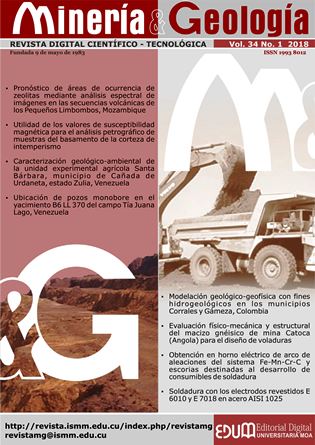Welding with coated electrodes E 6010 and E 7018 in AISI 1025 steel
Keywords:
welding, low carbon steel, E 6010 electrode, E 7018 electrode, microstructureAbstract
The welding of steel of low carbon content is a common practice in the nickel industry, where components with steels of these characteristics are manufactured. The objective of the paper was to establish the microstructural behavior of the AISI 1025 steel when it was welded with two types of electrodes (E 6010 and E 7018), the first one deposited as a mattress, and the second one to guarantee mechanical resistance; they were made in a 240 x 240 x 10 mm plate with simple bevel preparation. The microstructures obtained with the electrode E 6010 are of the ferrite type Widmanstátten, columnar ferrite and intergranular pearlite, with a hardness of 345 HV, while with the electrode E 7018 the microstructures are ferrite Widmanstátten, austenite and martensite, with hardness of 332 HV . The decrease in hardness in the latter case is associated with the thermal treatment of multipass annealing.Downloads
References
ALMAGUER, P. Y ESTRADA, R. Evaluación del comportamiento a fatiga de una unión soldada a tope de acero AISI 1015. Ingeniería Mecánica, 18(1): 31-41, 2015.
BAO, R. Y ZHANG, X. An inverse method for evaluating weld residual stresses via fatigue crack growth test data. Engineering Fracture Mechanics, 77(23): 3143-3156, 2010.
BURGOS, J. Y GARCÍA, Y. Obtención del campo de temperaturas en juntas soldadas mediante el empleo de MEF. Revista de la Facultad de Ingeniería de la U.C.V., 18(2): 31-37, 2003.
BHATTI, A.; BARSOUM, Z.; MURAKAWA, H. Y BARSOUM, I. Influence of thermo-mechanical material properties of different steel grades on welding residual stresses and angular distorsion. Materials and Design, 65(12): 878-889, 2015.
FERNÁNDEZ, T.; ALCÁNTARA, D.; RODRÍGUEZ, I. Y SABLÓN, L. Deposición de un recubrimiento base níquel para la unión metalúrgica del acero al carbono y el hierro fundido. Minería y Geología, 32(3): 159-174, 2016.
FUENTES, R.; FERNÁNDEZ, T.; GÁMEZ, O. Y DURÁN, N. Microestructura de una unión disímil AISI 321 y una aleación A 351 grado HK-40 obtenida mediante soldadura manual por arco eléctrico. Minería y Geología, 32(2): 112-123, 2016.
GARCÍA, A. Y SALAS, R. Metalurgia de uniones soldadas de aceros disímiles (ASTM A240–A537) y comportamiento mecánico ante cargas monotónica y cíclica. Revista Latinoamericana de Metalurgia y Materiales, 32(11): 36-48, 2011.
MADHUSUDAN, G. Y SRINIVASA, R. Microstructure and mechanical properties of similar and dissimilar stainless steel electron beam and friction welds. International Journal of Advance Manufacturing Technology, 45(5): 14-33, 2009.
MAROEF, I.; OLSON, D.; EBERHART, M. Y EDWARDS, G. Hidrógeno atrapado en la soldadura de un acero ferrítico. Revisión Internacional de materiales, 47(4): 191-223, 2002.
SURESH, K. Analytical Modeling of Temperature Distribution, Peak Temperature, Cooling Rate and Thermal Cycles in a Solid Works Piece Welded by Laser Welding Process. Procedia Materials Science, 6(2): 821-834, 2014.
SUSMEL, L. Modified Wöhler Curve Method and multiaxial fatigue assessment of thin welded joints. International Journal of Fatigue, 43(4): 30-42, 2012.
UTRIA, M.; LEYVA, B.; FERNÁNDEZ, T. Y RODRÍGUEZ, I. Efecto de las tensiones en la unión soldada tubo-brida del transportador de mineral reducido. Minería y Geología, 32(1): 76-92, 2016.
ZHANG, M.; KELLY, P. Y GATES, J. The effect of heat treatment on the toughness, hardness and microstructure of low carbon white cast irons. Journal of Materials Science, 36(15): 3865-3875, 2001.
Published
How to Cite
Issue
Section
Copyright (c) 2018 Dennis Reyes-Carcasés, Tomás Fernández-Columbié, Dayanis Alcántara-Borges, Isnel Rodríguez-González

This work is licensed under a Creative Commons Attribution-NonCommercial 4.0 International License.
- Authors retain copyright and guaranteeing the right magazine to be the first publication of the work as licensed under a Creative Commons Attribution-NonCommercial that allows others to share the work with an acknowledgment of the work's authorship and initial publication in this journal.
- Authors may establish separate supplemental agreements for the exclusive distribution version of the work published in the journal (eg, place it in an institutional repository or publish it in a book), with an acknowledgment of its initial publication in this journal.
- Authors are allowed and recommended to disseminate their work through the Internet (e.g., in institutional telematic archives or on their websites) before and during the submission process, which can produce interesting exchanges and increase citations of the published work. (See The effect of open access)










